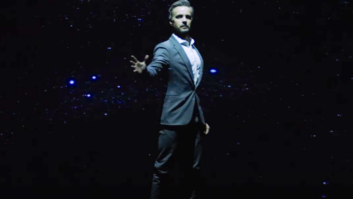New York
– Exactly one week before the home-video launch of the all-time box-office smash
“Avatar,”
brought the film’s producer Jon Landau here to discuss with reporters both the
making of the film and the state of the burgeoning 3D market.
The “roundtable” sessions will have to serve as the bonus
material for the initial Blu-ray release, since the Earth Day home-release
version will feature only the film in high-quality 2D. Standard-def DVDs will
also be available.
Those waiting for the
release will have to wait an indefinite
period, as the filmmakers and studio wait for sufficient penetration of 3D TV
displays to make an appropriately sized splash. However, those waiting for an
exhaustive 2D presentation of the film will be able to purchase a four-disc expanded
edition this fall.
What Landau had to say should come as good news to everyone in
the consumer electronics industry who is waiting to see if 3D for the home is
for real.
First, Landau said that with the success of the film we can
expect to see a flood of new 3D movies from
going forward, including every
future title to come from the Cameron/Landau team. Second, he said, the team is
very impressed with the quality of the first-generation TVs on the market this
year, and he his eager to fulfill the demand for content to maintain the
momentum.
The following are comments taken from a roundtable discussion
with the press on the “Avatar” home-video release:
Q: What aspect ratio format will the home-release version be in?
A: Jim has always been a 2:35:1 person,” Landau explained. “In
the release of the film, we released in both 2:35:1 and 16:9. For this movie,
though, he thought that 16:9 was actually the better way to see it because you
got to see more of the world. But we didn’t want to do that and give up the
width. There were theaters that when you projected it, if you ran the full
height, you had to come in on the width to gain that height, which we did not want
to do. But in the home entertainment release it is 16:9.
Q: How will you handle the bonus content on the eventual 3D
Blu-ray release? Will that be in 3D too?
A: “We haven’t even thought about the 3D version yet. Right now
we’re getting ready for the November release, where we will have added content,
and we want to make sure we have that right. We could not have made ready the
added content for this release now [April 22
nd
], and done it at the
level we wanted to do it at.”
Q: So, why now, instead of waiting until November?
A: Because people wanted it. If we didn’t do it now, pirate
people were going to do it now … And most people in the world don’t ever look
at the added-value content.
Q: What was your approach to using 3D in the production of “Avatar”?
A”: “The way we utilize 3D, it’s like a window coming into a
world not a world coming out of a window … If you can find a way to use 3D
within the context of your narrative we think it works. And I think the scene
where we used 3D the most was the scene in which the creatures land on him —
the wood sprites — because they were actually floating in front of the screen
plane and then came down. They were part of the narrative story flow. And your
eyes took you back to the screen. It wasn’t that whoops-you’re-out-of-it
sensation. I think when you do that, you’ve lost the audience.”
Q: What do you think about movies that are shot in 2D and are
then converted after the fact?
A: I think you can do that, but you have to accept that a
conversion is a creative process and not a technical process. It is not a
technical process that you can do in seven weeks and do it well. You have to
have the filmmakers involved. I think it takes time to do and then I think it
can be done right. It would be like saying to a filmmaker today: “Shoot your
film in black-and-white and we will colorize it for you while you’re finishing
the movie.” No filmmaker would do that, so why are you now doing that with 3D
all of a sudden?
We have done tests — and we intend to do “Titantic” in 3D — but
we will take a year to 18 months to do it, and Jim will be involved in it as
opposed to a technical person.
Q: What would you think about converting classics, like “Citizen
Kane,” for example?
A: I would not support that because Orson Wells isn’t here. If
you wanted to go do “ET” and have Steven [Spielberg] be involved in it, I think
that would be great. I think if you wanted to “Star Wars,” and I think George
[Lucas] is interested in that, that would be great, or “Lord of the Rings.” To
have someone else come in and interpret what they want is when you get into
trouble … I think right now, as an industry, the desire to make 3D has to come
from the filmmakers and not the studios. You don’t go up to a filmmaker and
say, “We want to make your film into an epic. We know it isn’t, but we want to
make it into one.”
A: What advice would you give to filmmakers looking to make 3D
productions?
Q: When you shoot something you mimic human vision so that the
audience doesn’t have to when they watch it back. By that I mean, our eyes are
always dynamic — they are always moving — if I am looking at my finger, my
eyes are converged there. If my finger comes into my face, my eyes are
narrowing down. If you do that with your camera system when you are filming,
the audience doesn’t have to when they are watching. If you converge on your
subject of focus, you can cut as fast as you want because where you are
converged is the relative screen plane. As an audience in the theater, my eyes
are always converged no matter what is happening.
Q: When you were shooting were you making different decisions on
how you made the 2D version vs. the 3D version?
A: No. Every decision we made editorially was a 2D decision. That
won’t change because the principles of story telling are 2D. Our release of the
movie in 2D — it’s one eye of the 3D.
Q: Do you have any feelings about the three different forms of
3D?
A: A little bit depends on the theater itself and projection
system they have in it. There are [two] big issues of 3D in theaters today: one
is the brightness level because there are certain theaters that allow you to
have brighter results. Two, is a frame-rate issue. In the 1920s somebody
arbitrarily came up with a rate of 24 frames per second, for no reason. It just
was, and it became the standard. So that’s why if you watch a projector running
without any film in it the light appears to be flashing. The refresh rate is
not fast enough for our eyes. When digitally projecting we see that as strobing,
and we’ve come to accept that in 2D. However, in 3D everything feels more real.
In real life we don’t have strobing. We can go to a higher frame rate now,
because the digital projection allows us to do that. So that’s something else
down the road we’d like to do — we would like to go to 48 or 60 frames per
second for movies. You will start to have more frames for articulating
animation, you’ll eliminating the strobing that is more exacerbated in 3D and
you’ll be brighter, because of the higher rate.
Q: Having touched off the frenzy of 3D production in Hollywood do you feel any
compulsion to do all of your future movies in 3D?
A: We’ll never do 2D again. It could be “My Dinner With Andre …”
There’s no reason to. We see life in 3D. For years we have enjoyed a more
immersive cinema-going experience because of stereo sound. But film is a visual
medium. 3D now catches up the visual side of the art form with the auditory
side of the art form.
I honestly believe, over time, every screen we look at will be 3D
from our mobile devices to our computers
Q: But will we have to wear glasses to see 3D on them all?
A: A couple of things — for 3D on a computer — no. In theaters,
for a long time, yes, and for the home market it is going to be in between
depending on how many people want to view. The problem with auto-stereoscopy is
there are only so many sweet spots. My question is how do we improve the
glasses? How do we make it so your prescription glasses, with a flick, become
your 3D glasses? How do you make the glasses you bring home from the theater
plug into your computer to view special content? How do we make your 3D glasses
become your sunglasses when you go out? People go to the beach all the time.
Wearing glasses is not an issue. Wearing bad glasses is an issue.
Q: Having seen the new generation of 3D TVs at CES, is there
anything the manufacturers can be doing to improve the experience?
A: It goes back to better glasses — ones that are lighter weight
and easier to use. I saw a Panasonic presentation with a 150-inch 3D plasma
screen, and I was blown away.
Q: But when you look at a 50-inch screen you have to sit pretty
close to have it be immersive.
A: Size is relevant. If you have a 50-inch you have to sit
closer. If you have a 150-inch you can sit farther away.
Q: There was a recent disclaimer issued about the possible health
risks to epileptics and people with certain other conditions in viewing 3D TV.
Will that interfere with your creative process in any way?
A: I’m not a doctor, but I know all of us see 3D all day long. I
would highly doubt [it will have any effect on our process.] The biggest
drawback for me on the glasses is the mark it leaves.













